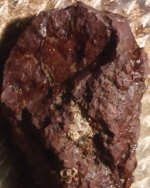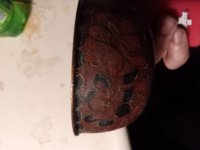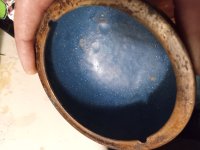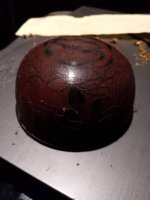Last edited:
Navigation
Install the app
How to install the app on iOS
Follow along with the video below to see how to install our site as a web app on your home screen.
Note: This feature may not be available in some browsers.
More options
You are using an out of date browser. It may not display this or other websites correctly.
You should upgrade or use an alternative browser.
You should upgrade or use an alternative browser.
Trying to figure out what this is I think it might be a sound bowl I found it at the bottom of the lake with the water that was being lower
- Thread starter Danual
- Start date
Can the forum God switch it over for me

Upvote
1
The bowl is manmade pottery made from clay. The rock is solid mineral, it is not clay. The two are unrelated except possibly in your mind?
Upvote
2
- Thread starter
- #11
I wasn't saying The Rock was Clay I was just saying it looks like the same color like maybe somebody crushed it up maybe pigmented bowl with it but it was found in a clay deposit at the bottom of the lake cuz the water levels are so low right now it's exposed and it hasn't been exposed for a long time there's quite a few clay deposits I found a bowl and a bunch of these rocks around it in the clay whenever I was digging to the clay playing with itThe bowl is manmade pottery made from clay. The rock is solid mineral, it is not clay. The two are unrelated except possibly in your mind?
Upvote
0
Pottery glazes are made of melted minerals so I can see how you might think powdered rock could be a glaze. I see the resemblance between the glaze on your bowl and the rock you found. Putting those things together might lead you to believe they are related. There are several reasons why that isn't a real possibility but instead is just a visual coincidence.
If you have ever worked with pottery glazes you know the raw unfired glaze material looks nothing like the final fired glaze result, colors and textures change as the glaze is exposed to high temperatures. The rock you are showing would not melt at even the highest temperatures a ceramic kiln can achieve so it couldn't be used as a glaze by itself.
Pottery glazes are composed of more than a crushed rock. Silica, Alumina and a flux mineral are required as a base to allow the glaze to melt at a lower temperature. The final glaze color is due to small quantity of powdered mineral additions and firing temperature variations.
By the time a glaze mineral is blended into the base and then melted at high temperatures the color and texture don't resemble the original mineral material. Even if you could use the rock as a glaze it wouldn't be the same color or texture as the original rock after it has been heated to the melting point.
If you have ever worked with pottery glazes you know the raw unfired glaze material looks nothing like the final fired glaze result, colors and textures change as the glaze is exposed to high temperatures. The rock you are showing would not melt at even the highest temperatures a ceramic kiln can achieve so it couldn't be used as a glaze by itself.
Pottery glazes are composed of more than a crushed rock. Silica, Alumina and a flux mineral are required as a base to allow the glaze to melt at a lower temperature. The final glaze color is due to small quantity of powdered mineral additions and firing temperature variations.
By the time a glaze mineral is blended into the base and then melted at high temperatures the color and texture don't resemble the original mineral material. Even if you could use the rock as a glaze it wouldn't be the same color or texture as the original rock after it has been heated to the melting point.
Last edited:
Upvote
4
That's why I said, 'Depending on what they are". .. It is possible to get pigment out of SOME minerals that could be used to color a glaze rather than simply using crushed rock itself.Pottery glazes are made of melted minerals so I can see how you might think powdered rock could be a glaze. I see the resemblance between the glaze on your bowl and the rock you found. Putting those things together might lead you to believe they are related. There are several reasons why that isn't a real possibility but instead is just a visual coincidence.
If you have ever worked with pottery glazes you know the raw unfired glaze material looks nothing like the final fired glaze result, colors and textures change as the glaze is exposed to high temperatures. The rock you are showing would not melt at even the highest temperatures a ceramic kiln can achieve so it couldn't be used as a glaze by itself.
Pottery glazes are composed of more than a crushed rock. Silica, Alumina and a flux mineral are required as a base to allow the glaze to melt at a lower temperature. The final glaze color is due to small quantity of powdered mineral additions and firing temperature variations.
By the time a glaze mineral is blended into the base and then melted at high temperatures the color and texture don't resemble the original mineral material. Even if you could use the rock as a glaze it wouldn't be the same color or texture as the original rock after it has been heated to the melting point.
Upvote
0
Color to be added to the silica, alumina and flux glaze out of some minerals could happen but never from a rock. The OP is showing a rock.That's why I said, 'Depending on what they are". .. It is possible to get pigment out of SOME minerals that could be used to color a glaze rather than simply using crushed rock itself.
The minerals most commonly used as coloring in glazes are all metal oxides or metal carbonates. Mostly combinations of copper, iron, chromium, vanadium and cobalt are used. These oxides and carbonates are created in a distinctly separate process usually involving quite a bit of other minerals, chemistry, grinding and heat processing. Although there are a few naturally occurring metal oxides and carbonates that can color glazes no modern potter would rely on those raw materials to produce commercial grade glazed pottery.
The OP shows a very professionally manufactured bowl with one of the glazed surfaces visually similar to the color of a rock they found. I can state with absolute certainty that the rock was not used in the creation of the glazes on the bowl shown.
Of course theoretically the rock could have been produced by an ancient society of bigfoot potters and buried so the OP could discover the rock after they acquired the bowl....
But I'm darn sure that didn't happen either
Upvote
1
- Thread starter
- #16
Big foot or Biden I need a word with both🤣Color to be added to the silica, alumina and flux glaze out of some minerals could happen but never from a rock. The OP is showing a rock.
The minerals most commonly used as coloring in glazes are all metal oxides or metal carbonates. Mostly combinations of copper, iron, chromium, vanadium and cobalt are used. These oxides and carbonates are created in a distinctly separate process usually involving quite a bit of other minerals, chemistry, grinding and heat processing. Although there are a few naturally occurring metal oxides and carbonates that can color glazes no modern potter would rely on those raw materials to produce commercial grade glazed pottery.
The OP shows a very professionally manufactured bowl with one of the glazed surfaces visually similar to the color of a rock they found. I can state with absolute certainty that the rock was not used in the creation of the glazes on the bowl shown.
Of course theoretically the rock could have been produced by an ancient society of bigfoot potters and buried so the OP could discover the rock after they acquired the bowl....
But I'm darn sure that didn't happen either
Upvote
0
- Thread starter
- #17
That red rock hangs up my my metal detector and 90 which is in line with iron oxides and she crack open that rock so really rusted powdery iron oxide looking stuff there's all kinds of this broken stuff up by a Cooley living quarters where they made pottery that same blue porcelain stuff is broken everywhere around this little Hut not saying where it's at but manganese oxide mine with the rim of this bowl is not gold metal detector says 90 it's a gold racer mackerelBig foot or Biden I need a word with both🤣
Upvote
0
- Thread starter
- #18
I'm trying to say this is ancient super hot molded Rock glass porcelain stuff you can see in the picture and the porcelain the blue stuff there's a imperfection if you look on the coinciding part that is red it looks like glass clear glass can you see light through it if you put a flashlight on it it was fired and some kind of kim old Kim
Upvote
0
- Thread starter
- #19
I'm trying to say this is ancient super hot molded Rock glass porcelain stuff you can see in the picture and the porcelain the blue stuff there's a imperfection if you look on the coinciding part that is red it looks like glass clear glass can you see light through it if you put a flashlight on it it waspp it all comes up as if it was a hot rock on fired and some kind of kim old Kim
You sound like a prospector like myself that little shack I found by the manganese mine that was inhabited by Cooley workers well I found porcelain pottery just like this one with the blue inside but never a full piece never a full bowl you don't think that could have been an assay shop where they did a little bit with porcelain too Cooley assayer quite a bit different than a 1800s American assayerColor to be added to the silica, alumina and flux glaze out of some minerals could happen but never from a rock. The OP is showing a rock.
The minerals most commonly used as coloring in glazes are all metal oxides or metal carbonates. Mostly combinations of copper, iron, chromium, vanadium and cobalt are used. These oxides and carbonates are created in a distinctly separate process usually involving quite a bit of other minerals, chemistry, grinding and heat processing. Although there are a few naturally occurring metal oxides and carbonates that can color glazes no modern potter would rely on those raw materials to produce commercial grade glazed pottery.
The OP shows a very professionally manufactured bowl with one of the glazed surfaces visually similar to the color of a rock they found. I can state with absolute certainty that the rock was not used in the creation of the glazes on the bowl shown.
Of course theoretically the rock could have been produced by an ancient society of bigfoot potters and buried so the OP could discover the rock after they acquired the bowl....
But I'm darn sure that didn't happen either
Upvote
0
- Thread starter
- #20
You don't think of that popping there with my dry washer metal detector around a little bit I won't find a bunch of little manganese ballsYou sound like a prospector like myself that little shack I found by the manganese mine that was inhabited by Cooley workers well I found porcelain pottery just like this one with the blue inside but never a full piece never a full bowl you don't think that could have been an assay shop where they did a little bit with porcelain too Cooley assayer quite a bit different than a 1800s American assayer
Upvote
0
Top Member Reactions
-
 3591
3591 -
 2080
2080 -
 2056
2056 -
 1199
1199 -
 1089
1089 -
 931
931 -
 892
892 -
 828
828 -
 806
806 -
 799
799 -
 784
784 -
 547
547 -
 537
537 -
 489
489 -
 468
468 -
 443
443 -
 429
429 -
E
428
-
 423
423 -
 406
406
Users who are viewing this thread
Total: 2 (members: 0, guests: 2)








